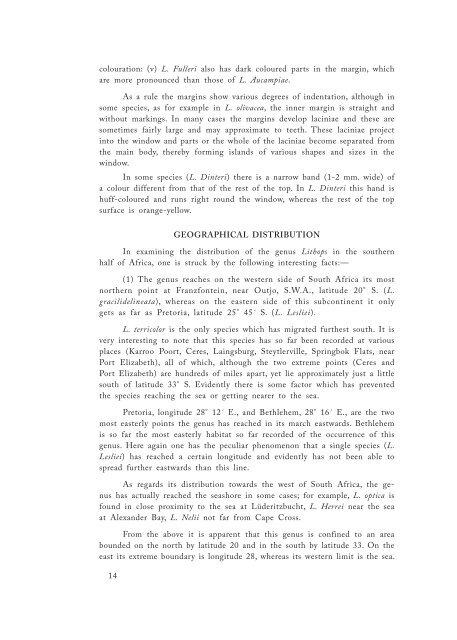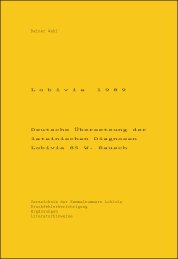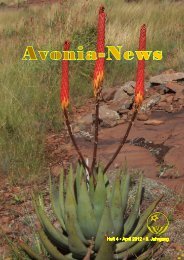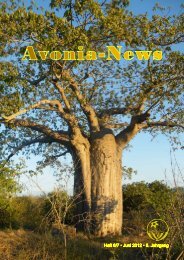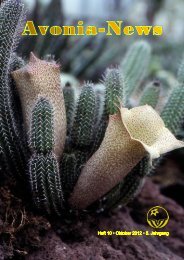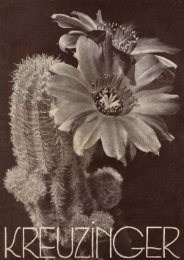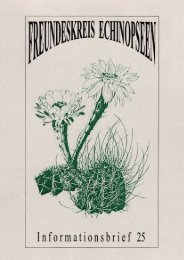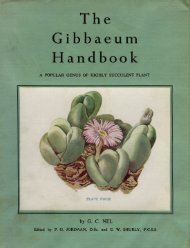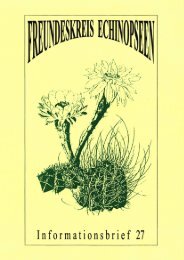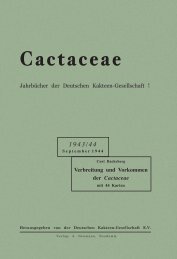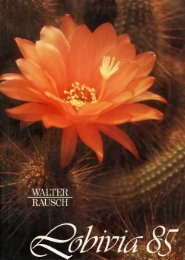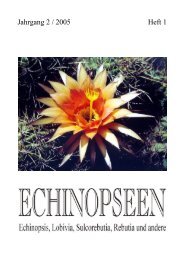Lithops - Au Cactus Francophone
Lithops - Au Cactus Francophone
Lithops - Au Cactus Francophone
You also want an ePaper? Increase the reach of your titles
YUMPU automatically turns print PDFs into web optimized ePapers that Google loves.
colouration: (v) L. Fulleri also has dark coloured parts in the margin, which<br />
are more pronounced than those of L. <strong>Au</strong>campiae.<br />
As a rule the margins show various degrees of indentation, although in<br />
some species, as for example in L. olivacea, the inner margin is straight and<br />
without markings. In many cases the margins develop laciniae and these are<br />
sometimes fairly large and may approximate to teeth. These laciniae project<br />
into the window and parts or the whole of the laciniae become separated from<br />
the main body, thereby forming islands of various shapes and sizes in the<br />
window.<br />
In some species (L. Dinteri) there is a narrow band (1 2 mm. wide) of<br />
a colour different from that of the rest of the top. In L. Dinteri this hand is<br />
huff coloured and runs right round the window, whereas the rest of the top<br />
surface is orange yellow.<br />
GEOGRAPHICAL DISTRIBUTION<br />
<strong>Lithops</strong> > <strong>Lithops</strong><br />
In examining the distribution of the genus <strong>Lithops</strong> in the southern<br />
half of Africa, one is struck by the following interesting facts:—<br />
(1) The genus reaches on the western side of South Africa its most<br />
northern point at Franzfontein, near Outjo, S.W.A., latitude 20° S. (L.<br />
gracilidelineata), whereas on the eastern side of this subcontinent it only<br />
gets as far as Pretoria, latitude 25° 45´ S. (L. Lesliei).<br />
45’ > 45´<br />
L. terricolor is the only species which has migrated furthest south. It is<br />
very interesting to note that this species has so far been recorded at various<br />
places (Karroo Poort, Ceres, Laingsburg, Steytlerville, Springbok Flats, near<br />
Port Elizabeth), all of which, although the two extreme points (Ceres and<br />
Port Elizabeth) are hundreds of miles apart, yet lie approximately just a little<br />
33 S > 33° S<br />
south of latitude 33° S. Evidently there is some factor which has prevented<br />
the species reaching the sea or getting nearer to the sea.<br />
12’ > 12´ 16’ > 16´<br />
Pretoria, longitude 28° 12´ E., and Bethlehem, 28° 16´ E., are the two<br />
most easterly points the genus has reached in its march eastwards. Bethlehem<br />
is so far the most easterly habitat so far recorded of the occurrence of this<br />
genus. Here again one has the peculiar phenomenon that a single species (L.<br />
Lesliei) has reached a certain longitude and evidently has not been able to<br />
spread further eastwards than this line.<br />
As regards its distribution towards the west of South Africa, the ge<br />
nus has actually reached the seashore in some cases; for example, L. optica is<br />
found in close proximity to the sea at Lüderitzbucht, L. Herrei near the sea<br />
at Alexander Bay, L. Nelii not far from Cape Cross.<br />
From the above it is apparent that this genus is confined to an area<br />
bounded on the north by latitude 20 and in the south by latitude 33. On the<br />
east its extreme boundary is longitude 28, whereas its western limit is the sea.<br />
14


